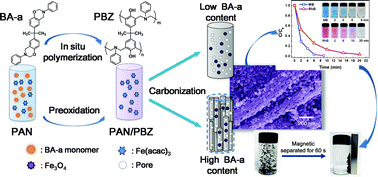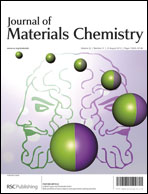Hierarchical porous, magnetic Fe3O4@carbon nanofibers (Fe3O4@CNFs) comprising graphitic nanofibers and embedded Fe3O4 nanocrystals were prepared by using electrospun polyacrylonitrile/polybenzoxazine (PBZ) nanofibers as composite carbon precursor. By the combination of precursor design and activation process, a series of Fe3O4@CNFs with a tunable porous structure including the surface area, pore volume and micro/mesopore ratio were obtained, and could achieve an extremely high surface area of 1623 m2 g−1 and a pore volume of 1.635 cm3 g−1. Quantitative pore size distribution and fractal analysis were employed to investigate the hierarchical porous structure using N2 adsorption methods and synchrotron radiation small-angle X-ray scattering measurements. The role of the precursor structure and activation treatment for the tuning of the porous structure and surface fractal dimension is discussed, and the relative fraction of closed and open pores in CNFs is confirmed. Furthermore, the as-prepared Fe3O4@CNFs exhibit efficient adsorption for organic dyes in water and excellent magnetic separation performance, which would make them a promising adsorbent for water treatment, and a new insight was also provided into the design and development of functional carbon nanomaterials based on PBZ precursor.

You have access to this article
 Please wait while we load your content...
Something went wrong. Try again?
Please wait while we load your content...
Something went wrong. Try again?


 Please wait while we load your content...
Please wait while we load your content...